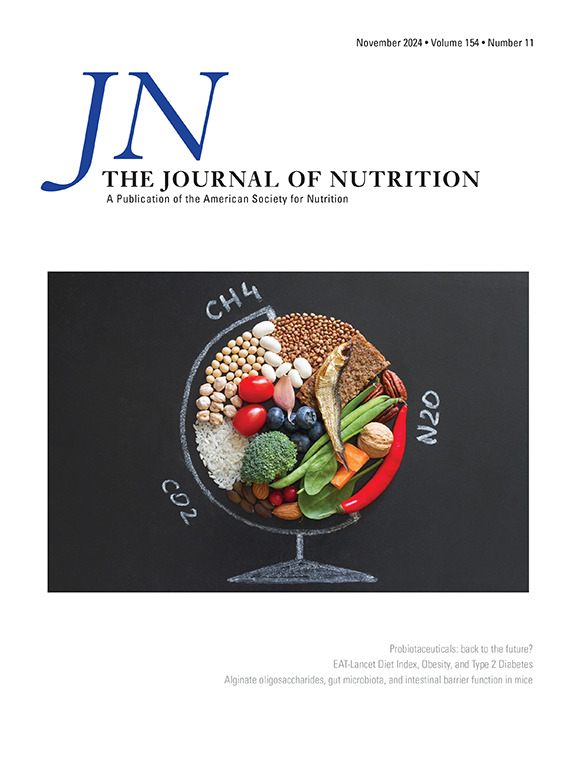基于 1H NMR 的代谢组学分析以及分泌乳汁者和非分泌乳汁者不同哺乳期母乳的比较:中国哺乳期妇女研究》。
IF 3.7
3区 医学
Q2 NUTRITION & DIETETICS
引用次数: 0
摘要
背景:母乳低聚糖(HMOs)和其他乳源性代谢物对婴儿健康至关重要,影响着肠道微生物群和整体发育:本研究旨在揭示基于分泌物(Se)状态、哺乳时间、分娩方式和婴儿性别的 HMOs 和非 HMO 代谢物的变化:这项探索性横断面研究旨在比较 129 名中国哺乳期妇女产后一年内乳汁样本中 HMOs 和非 HMOs 代谢物的水平。研究采用核磁共振分析方法对代谢物进行鉴定和定量。测定的代谢物分为糖类、游离氨基酸、脂肪酸和与能量代谢有关的代谢物。研究还探讨了分娩方式和婴儿性别对母乳代谢物组成的影响:结果:对 HMOs 图谱进行的 Uniform Manifold Approximation and Projection (UMAP) 分析表明,基于 Se 状态的聚类特征明显,Se+ 组和 Se- 组之间的 2'-FL 和 3-FL 水平存在显著差异。在产后 12 个月内,随着哺乳期的延长,2'-FL 和 6-'SL 水平呈下降趋势,3-FL 水平则有所上升。非 HMOs 代谢物分析表明,Se 状态只影响谷氨酸水平。在产后 3-9 个月内,谷氨酰胺水平有所上升。在产后 12 个月内,邻磷酸胆碱水平持续上升,柠檬酸盐和 sn-甘油磷酸胆碱水平下降。分娩方式和婴儿性别对 HMOs 和非 HMOs 水平没有影响:人乳的代谢组学分析表明,根据 Se 状态,HMOs(而非 HMOs)存在显著差异。某些 HMOs 和非 HMOs 的水平在哺乳期一年内也发生了变化。了解这些代谢物随时间的变化可能会影响对产妇饮食、补充剂和母乳喂养时间的建议,以确保向婴儿提供最佳营养。本文章由计算机程序翻译,如有差异,请以英文原文为准。
1H Nuclear Magnetic Resonance-Based Metabolomic Profiling and Comparison of Human Milk across Different Lactation Stages in Secretors and Nonsecretors: A Study of Chinese Lactating Women
Background
Human milk oligosaccharides (HMOs) and other milk-derived metabolites are crucial for infant health, influencing gut microbiota and overall development.
Objective
This study aimed to uncover insights into the variations of HMOs and non-HMO metabolites based on secretor (Se) status, lactation time, mode of delivery, and infant sex.
Methods
An exploratory cross-sectional study was designed to compare the concentrations of HMOs and non-HMOs metabolites in milk samples from 129 lactating Chinese women within 1 y postpartum. Nuclear magnetic resonance analysis was employed for the identification and quantification of the metabolites. The metabolites measured were grouped into sugars, free amino acids, fatty acids, and metabolites related to energy metabolism. The influences of delivery mode and infant sex on milk metabolite composition were explored.
Results
Uniform Manifold Approximation and Projection analysis of HMOs profiles revealed distinct clustering based on Se status, with significant differences in 2′-fucosyllactose (2′-FL) and 3-fucosyllactose (3-FL) concentrations observed between Se+ and Se– groups. A decreasing trend for 2′-FL and 6′-sialyllactose concentrations, along with an increase in 3-FL concentrations, was observed with increasing lactating period within 12 mo postpartum. Non-HMOs metabolite analysis indicated that Se status only affected glutamate concentrations. An increase in glutamine concentrations was observed 3–9 mo postpartum. A continuous increase in o-phosphocholine concentrations was noted in 12 mo postpartum, along with reductions in citrate and sn-glycero-phosphocholine concentrations. Delivery mode and infant sex did not affect both HMOs and non-HMOs concentrations.
Conclusions
Metabolomic analysis of human milk reveals significant variation of HMOs, but not in non-HMOs, based on Se status. Changes in certain HMOs and non-HMOs concentrations were also observed over the 1 y of lactation. Understanding how these metabolites change over time may influence recommendations for maternal diet, supplementation, and the timing of breastfeeding to ensure optimal nutrient delivery to the infant.
求助全文
通过发布文献求助,成功后即可免费获取论文全文。
去求助
来源期刊

Journal of Nutrition
医学-营养学
CiteScore
7.60
自引率
4.80%
发文量
260
审稿时长
39 days
期刊介绍:
The Journal of Nutrition (JN/J Nutr) publishes peer-reviewed original research papers covering all aspects of experimental nutrition in humans and other animal species; special articles such as reviews and biographies of prominent nutrition scientists; and issues, opinions, and commentaries on controversial issues in nutrition. Supplements are frequently published to provide extended discussion of topics of special interest.
 求助内容:
求助内容: 应助结果提醒方式:
应助结果提醒方式:


